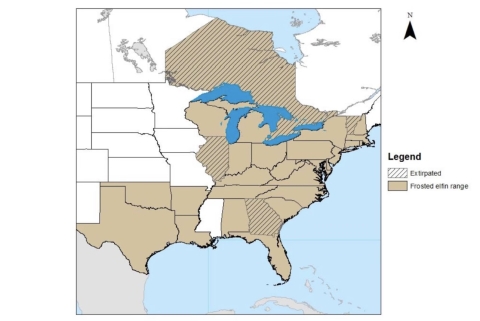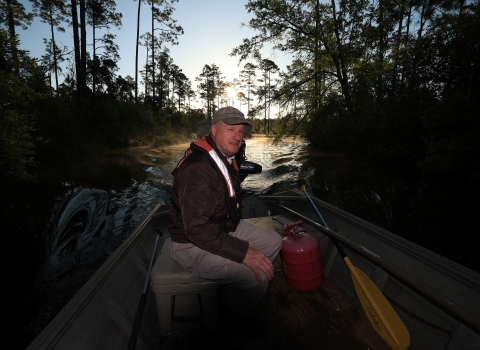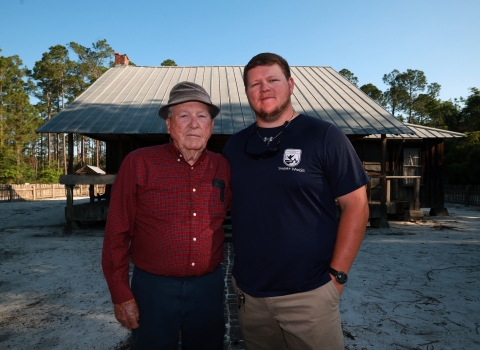When you picture a butterfly, you may first think of spectacularly colored wings of orange, blue or yellow darting around your garden, gracefully floating from petal to leaf and back again.
However, the frosted elfin likes to keep things understated. Looking across the landscape, this butterfly — with muted gray-brown wings and an average wingspan of 0.87 to 1.42 inches (22 to 36 mm) — may not catch your eye.
Spotting one is made even more difficult by the rapid decline in the species’ population in recent years. We’re working with partners to reverse that trend.
Housing crisis for butterflies
Historically, frosted elfin butterflies could be found across eastern North America ranging from Texas and Florida to Ontario, Canada. But habitat loss has significantly shrunk their range.
Frosted elfins make their homes in pine barrens. These unique landscapes are defined by fire-dependent conifers, dense coverings of shrubs, and grassy clearings, all nestled in sandy soil. These unique landscapes were historically maintained with wildfire or controlled burns conducted by Native Americans. The butterflies are quite particular in their choice of host plants and rely solely on two species, wild indigo (Baptisia species) and wild lupine (Lupinus perennis).
The frosted elfin is a non-migratory species and completes its entire year-long life cycle on these plants. In early spring, adults emerge from their pupa, mate and lay eggs on the leaves of a host plant. Once hatched, the larvae feed on the plant until they pupate in mid-summer. They remain in this chrysalis-state until the following spring, when the new generation of adult butterflies emerges to carry out the same cycle.
Habitat loss, largely due to development, has reduced the suitable growing environment for the frosted elfin’s host plants, in turn limiting space for the butterflies to lay eggs and feed.
In 2018, the U.S. Fish and Wildlife Service conducted an Interim Species Status Assessment across the frosted elfin’s range to determine the health of the population. In partnership with state agencies, we determined that the species is likely no longer present in pockets across its range, including Georgia, Illinois and Ontario, Canada. The steep decline of the species is largely tied to the scarcity of its host plants.
Wild lupine and false blue indigo have succumbed to browsing by deer and lack of suitable habitat. Pine barrens are specialized habitat types and require regular exposure to fire to maintain the unique landscape characteristics.
Blazing the path forward
In response to the needs of the frosted elfin, we partner with state agencies and nongovernmental organizations to support the species.
Biologists determined it was necessary to improve habitat management in the butterfly’s range within Maryland, with the goal of beginning a captive-breeding program to increase the population.
We worked with The Nature Conservancy to adapt prescribed fire plans used to maintain the pine barrens. Spring burns can catch the newly emerged population of frosted elfins while they’re mating, effectively killing some of the next generation. The burns also reduce the number of host plants for the surviving population to lay their eggs on. To allow the existing frosted elfin population to regenerate, biologists have decided to use manual habitat management practices like clearing tree canopy with saws and applying herbicide to target plant species that disrupt the balance of the landscape.
Creating a home takes time
Beginning in 2022, wildlife biologists from our Chesapeake Bay Field Office in Annapolis, Maryland, joined scientists from Maryland Department of Natural Resources to propagate the host plants the frosted elfin critically relies on.
Using greenhouse facilities, our biologists grow wild lupine and false blue indigo from seed collected from mature plants thriving in Nassawango Creek Preserve, which is known habitat for the frosted elfin on the Eastern Shore of Maryland.
“It’s critical that we do all that we can to create a suitable habitat for frosted elfin,” says Dimitri Rucker, a wildlife biologist and Roger A. Young Fellow for the Service. “Propagating these plant species supports the butterfly as well as increasing the abundance of this vital plant species and can benefit other species also inhabiting the landscape.”
After about two years of growth under greenhouse conditions, the seedlings are expected to be viable to transplant in areas with populations of frosted elfin, providing the resources to support a larger butterfly population in the coming years.
Most recently, we and our partners have expanded our plans and are using the plants grown in these greenhouses to develop a seed bank for wild lupine that can be used in the future to continue to bolster the population. It’s crucial to have seed from plants native to the area to preserve the genetics that have successfully supported frosted elfin in the past. With time, these efforts may secure a source of vital host plants for generations of frosted elfin.
While the road ahead is lengthy and uncertain, we’re hopeful we can change the trajectory for a butterfly that's easy to miss, but impossible to replace. Working with partners, we’re mapping the way.






